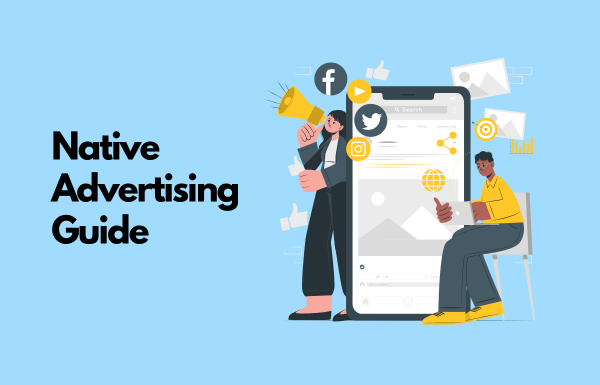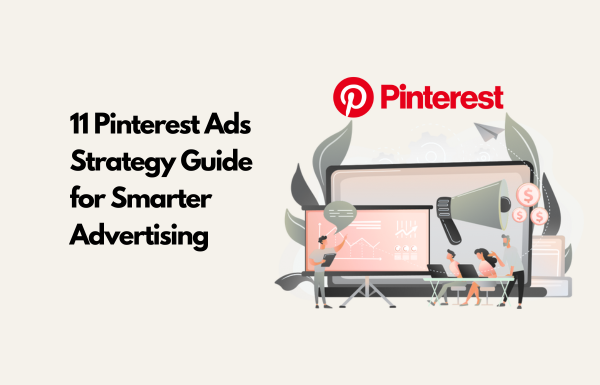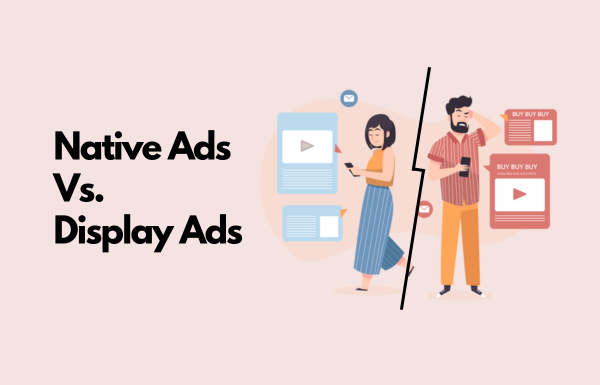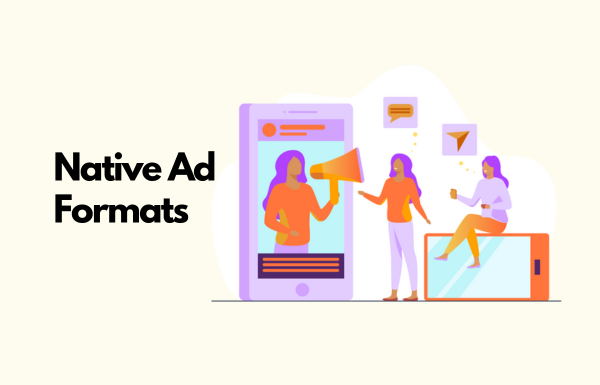Advertisers are working day and night to grow revenue. And most consumers (including myself) go the extra mile to swipe away from every ad coming on the way.
‘What a waste of money & effort for business owners and advertisers!’
Native Advertising is a solution as it helps your ads get noticed without making them annoying for users; compared to those loud & flashy banners of traditional marketing. And it’s no surprise that a growing number of marketers and business owners are turning toward it.
You might as well have a lot of doubts & questions.
In this blog, we’ll swim through what native advertising is, how it differs from traditional marketing, why it works, its available types, best practices, and more. We’ll also look at examples of native ads.
Let’s start with the native advertising definition.
What Is Native Advertising?
Native advertising is a type of paid media that blends with the format, style, content, and tone of the platform on which it appears. These ads are designed specifically to fit with surrounding content and give off a more organic and less intrusive feel.
The name ‘Native Advertising’ suggests a type of ad that seems native to the platforms they are advertised on.
At the core, Native Ads focus more on delivering value at first, be it through content or storytelling, while still meeting marketing goals to spread awareness, and bring in engagement and conversions. It’s more about striking the right balance between visibility and subtlety, which is exactly why it works for campaign success.
You’ve likely come across native ads without even realizing it, mostly, in form of recommended content.
For example: “sponsored articles on news websites, promoted listings in search results, and “recommended for you” content widgets are all examples of native advertising.”
What sets native advertising apart is that such types of ads are designed to match the user experience rather than interrupt it. With that, let’s understand better how it differs from traditional ads.
How Does Native Ads Differ from Traditional Ads?
The core difference between native ads and traditional ads is:
- ‘how the message is delivered’
- ‘how it’s received’
- ‘how well it aligns with the user’s content experience’
See, traditionally ads are designed to stand out (sometimes a little too much).
Whether it’s banners, pop-ups, or pre-roll videos, these formats interrupt the user experience to deliver a clear, often promotional message. Also, they seem very flashy and obvious to be ads.
In some cases, that approach can be effective.
Native ads, on the other hand, seem to create a flow rather than disrupt where it aligns with the platform’s content in terms of style, tone, and format. The goal here stays constant about showing ads as part of the experience, not apart from it.
Here’s a basic table difference between native ads and traditional ads.
|
Aspect |
Traditional Ads |
Native Ads |
|
Format |
Interruptive & obvious |
Seamless & integrated |
|
User Experience |
Disrupts flow |
Matches the platform’s tone |
|
Engagement |
Often ignored or blocked |
Higher viewability and interaction |
|
Trust |
Perceived as “salesy” |
Feels more authentic |
|
Strategy |
Sell directly |
Offer value, then convert |
Moreover, here I’ve added native advertising examples that help spot a clear difference between native ads and traditional ads that we see all over the internet.

You can see how native ad placements seem part of the content and design and traditional banners are trying their best to differentiate from platform design.
But do you wonder why your ads need to blend in with the platform’s content? Let’s understand that now.
Why Should Your Ads Blend With the Platform’s Content and Design?
The entire internet, be it search engines, social media platforms, news platforms, music platforms, video streaming platforms, shopping sites, or you name the platform type, and they all have ads; all over.
Basically, the internet has become an Ad City of a kind.
With ads overflowing everywhere, users have become masters in filtering out anything that feels overly promotional or out of place. And it’s natural. Our brains are constantly filtering information to avoid overload.
People have developed what’s called “banner blindness”.
When you surf the internet, you can check your own behavior. We instinctively skip over anything that looks like an obvious ad. We skip pre-rolls, banners, and install ad blockers proudly.
Don’t we? See, we’re wired to avoid what feels like an ad.
However, when an ad follows the format and tone of organic content, it doesn’t trip those mental alarms that make us avoid it. And instead, the familiarity will bring our attention to it as we’re more receptive to what feels familiar.
And that’s exactly why native content marketing is highly necessary to consider.
And it’s not that people hate ads. It’s that ads are on every platform and people don’t like being interrupted. So:
- If your ads are placed relevantly alongside familiar content, people will consider looking at them.
- And if an ad screams “I’m trying to sell you something”, most users are already gone.
This is exactly why ads that blend in — rather than stand out — often perform better.
Native ads help you do just that. But again, let’s read better on why native ads work.
Why Native Advertising Works?
Native advertising provides better results as it considers human psychology and aligns with user behavior, and content expectations. Apart from that, there are multiple aspects of native advertising that help bring success to your ad campaign.
Let’s talk about them.
1. They’re Placed Contextually
Native ads often succeed because they’re placed contextually. They show up alongside related content or within topics users are already exploring. This makes the message feel like part of the experience rather than a distraction from it. When users don’t feel like they’re being sold to, they’re more likely to engage.
So, they might think “This might be good to explore” instead of “Damnnn, another ad”.
2. It Gets Past Ad Blockers, Effortlessly
Millions of users today, use ad blockers to clean up their browsing experience.
Since native ads are integrated directly into the content experience, they appear as sponsored articles, recommended posts, or in-feed placements, they slip past most ad-blocking software. This means, your ad doesn’t just avoid disruption; it actually reaches the audience, right where they’re already paying attention.
3. They Blend In But Still Stand Out
Native ads are designed to match the look, feel, and function of the platform they appear on.
Unlike disruptive banners or popups, they blend into the user’s content experience, making them less intrusive.
However, great native ads also stand out through relevance. Doing it right helps you build content that resonates so well with the audience that they want to engage. So, you could call it more about balancing subtlety and providing value without shouting for it.
4. It Boosts Engagement and ROI
Traditional ads often feel salesy or pushy, so people often go blind to them.
Native ads, on the other hand, prioritize content and context where it delivers value first, through education, storytelling, or entertainment. When users find real value in the content, they’re more likely to trust the brand behind it.
5. It Feeds Into a Stronger Content Strategy
Native advertising ties in a broader content marketing ecosystem.
A strong native advertising strategy can drive traffic to a blog, improve an existing campaign, or support a brand narrative. Because it’s built around value-driven content, it works hand-in-hand with your organic efforts and helps improve your overall brand presence and visibility.
These were some of the reasons why native advertising succeeds. Mostly because native ads put the audience first. So, if you’re looking to run ad campaigns that feel less like ads and more like experiences, native ads are the way to go.
With that, let’s learn the types and forms of native ads that you can consider for your coming campaign.
Types of Native Advertising
Native ads are placed in different formats across various platforms, using different approaches.
To make the most of native advertising, it’s important to understand the various formats and platforms. Each type serves a unique purpose depending on your audience, platform, and campaign goals.
Here are the main types of native ad formats with native advertising examples that you should know.
In-Feed Ads
In-feed ads appear in social media feeds or news feeds.
They’re designed to blend right into your browsing experience. This is the kind of native ads you come across every day as you scroll through social media platforms. They don’t scream advertisement; instead, they match the platform’s organic content, making them feel like a natural part of your feed.
As a result, they’re more likely to grab attention without disrupting the user experience.
You can check on the three most common in-feed ad types that you’re familiar with.
1 – Instagram In-feed Ads
When you scroll through your Instagram feed, you’ll notice ads that come in between posts, stories, and reels.
They’re almost identical to the content that you usually explore on social platforms.
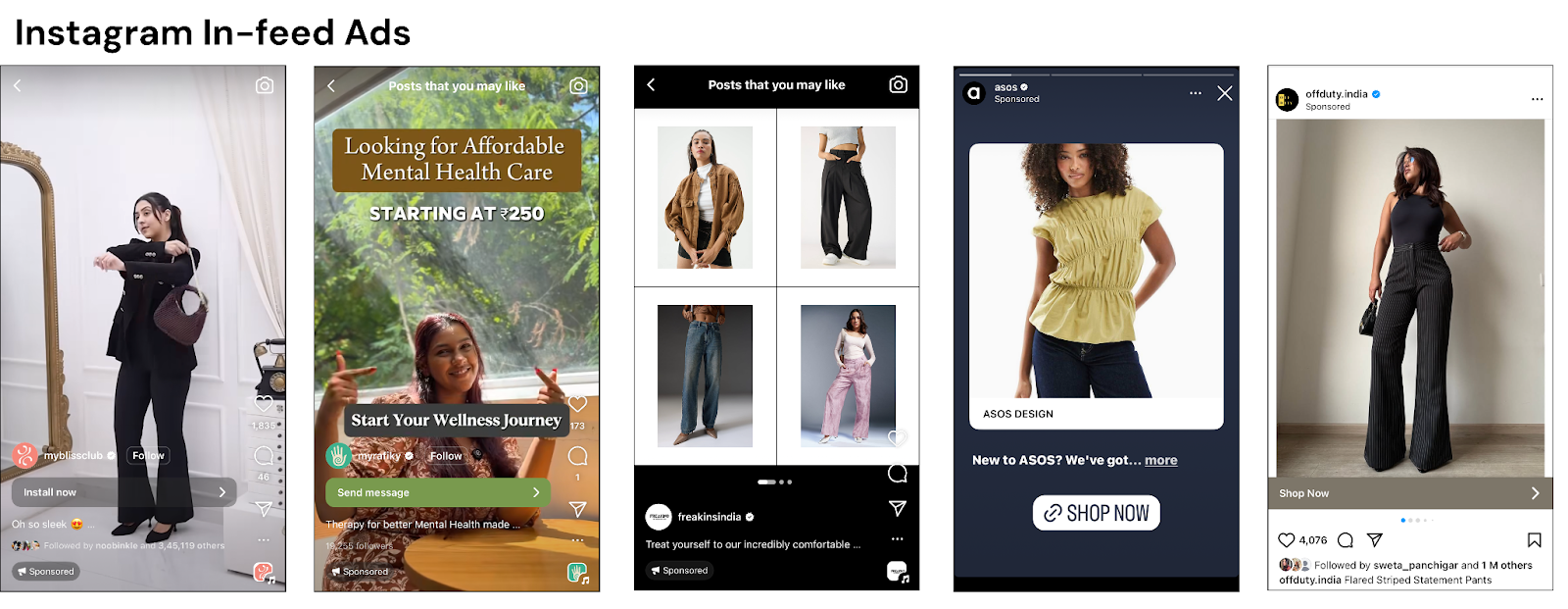
Instagram ads come with attractive images or videos, featuring a product/service and a small “Sponsored” tag at the top or bottom. These are mobile native advertising examples from Instagram Feed, you can see how seamlessly inserted between the organic content in your feed. This make them feel like just another piece of native content you might engage with.
These ads can include product photos, behind-the-scenes looks, influencer endorsements, or even short video clips, designed to capture your attention in the first few seconds. That’s the first example of native ads that you come across daily.
❓ Why It Works:
See, Instagram is a highly visual platform. People come here for pretty pictures and videos.
When brands also create visually appealing ads that feel like they belong on your feed, you won’t feel that you’re being sold to. And instead, it feels like you’re discovering something cool and relevant.
2 – YouTube In-feed Ads
You’ve probably noticed the ads that show up in your when scroll across the YouTube feed or YouTube Shorts.
These are Discovery Ads, appearing in the home feed, search results, or even in the “Up Next” section after you finish watching a video. They have a thumbnail that resembles the videos you’d typically watch, but with the “Ad” label, so you know it’s sponsored content.
Here are a few screenshots of Native Ads on Youtube, so you could familiarize yourself with this format.
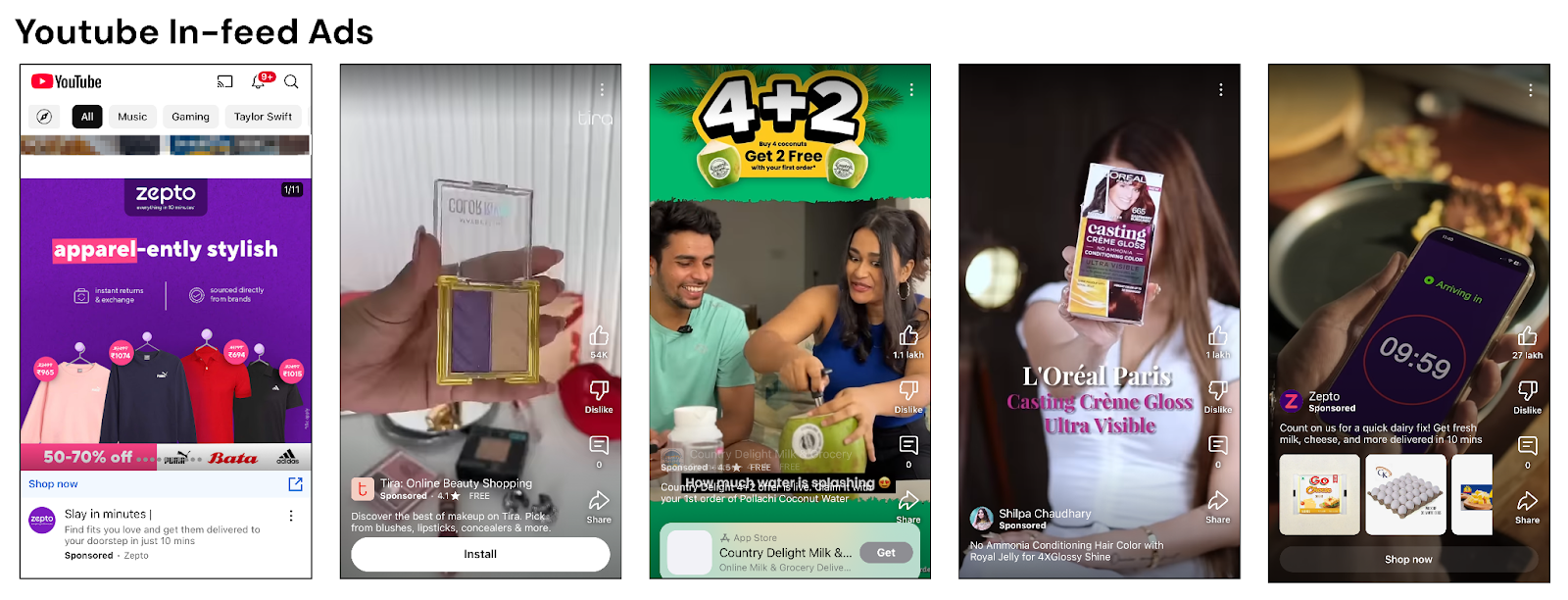
The format is super effective because it doesn’t just interrupt your video-watching experience, it invites you to watch something new and relevant.
❓ Why It Works:
People go on YouTube for video content, so the best way to engage them is through—what else?—more videos!
3 – Facebook In-feed Ads
Scrolling through Facebook, you’ll come across ads that look just like the posts from your friends or the brands you follow. They may include images, videos, or even carousel ads with multiple product images and similar visuals.
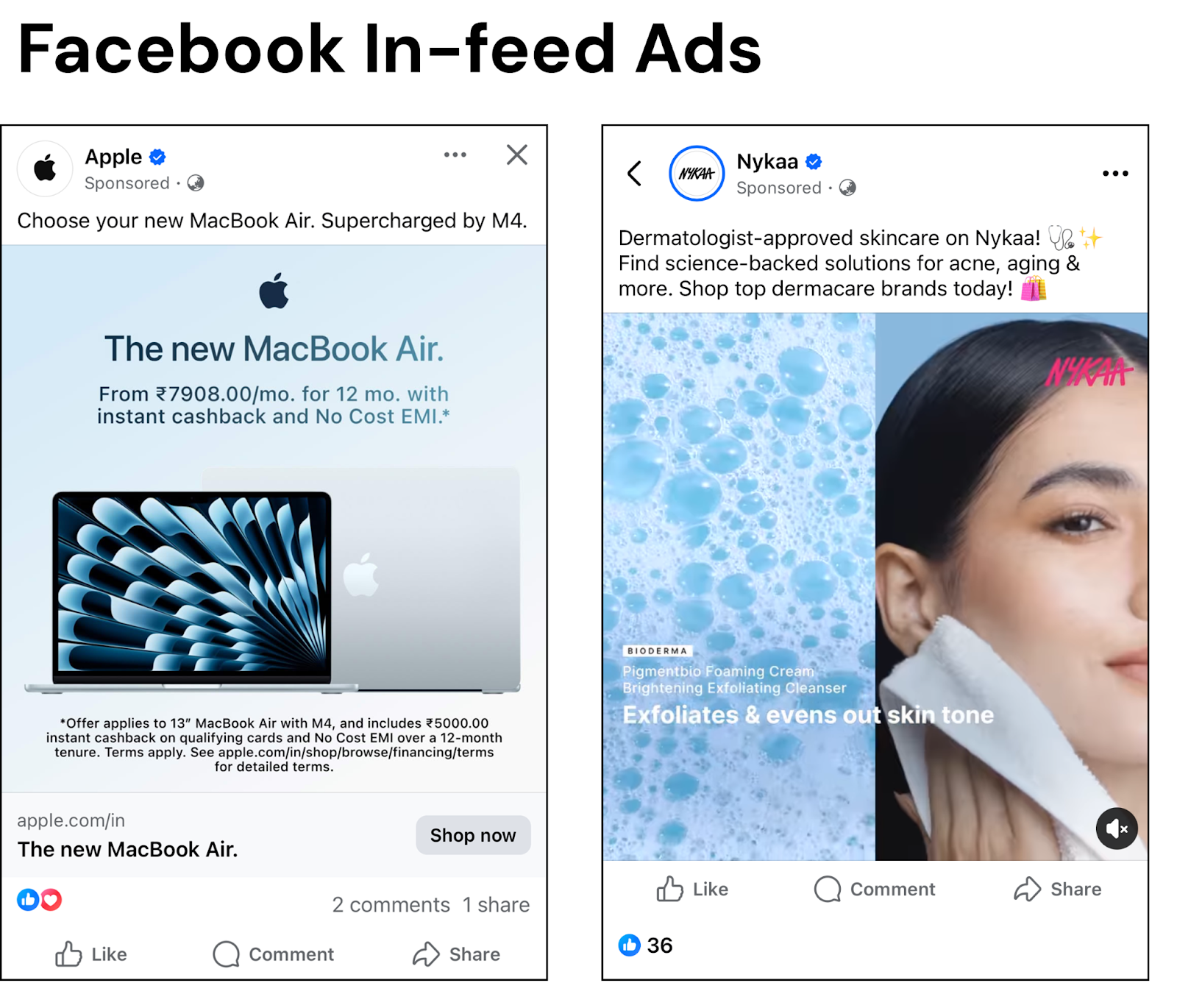
Each post includes a “Sponsored” label, but besides that, they look and feel like a regular Facebook post—whether it’s a funny meme, a heartfelt video, or a product review.
They show up right in your feed, so it’s easy for users to engage with them without feeling like they’ve left their social experience.
❓ Why It Works:
Facebook is all about connection and interaction. When ads look and feel like the content users are used to engaging with, they’re more likely to stop, take a second look, and even click through.
Facebook’s algorithm also helps to serve ads that match your interests, making them more relevant and engaging.
Search and Promoted Listings
If you’ve ever searched for a product on Google or browsed listings on Amazon, you’ve definitely seen search and promoted listings. These are native ads that appear at the top of your search results or shopping feeds.
What makes them “native” is that they look like regular search results or product listings but they’re strategically placed and paid for.
1 – Native Ads on Google
Take Google Ads, for example.
When you search for something like “leather shoes“, the top few results often appear as native display ads—they include a small “Sponsored” label but visually blend in with organic search results.
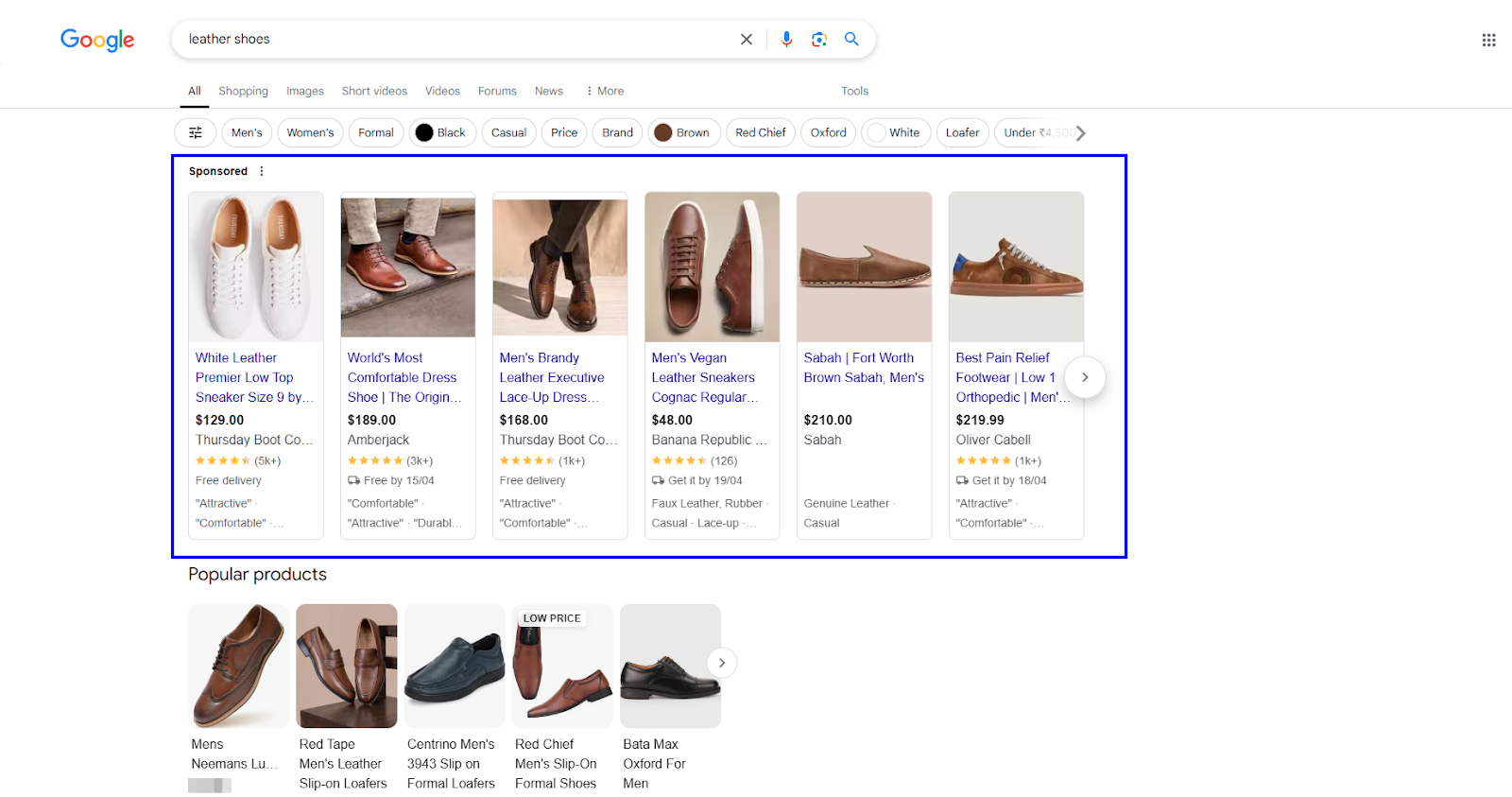
2 – Native Ads on Amazon
On Amazon advertising, sponsored products appear in your search results, product carousels, or even on competitors’ product pages, but they look and behave exactly like regular listings.
Here’s an example of a Native ad placement on the Amazon search results page.
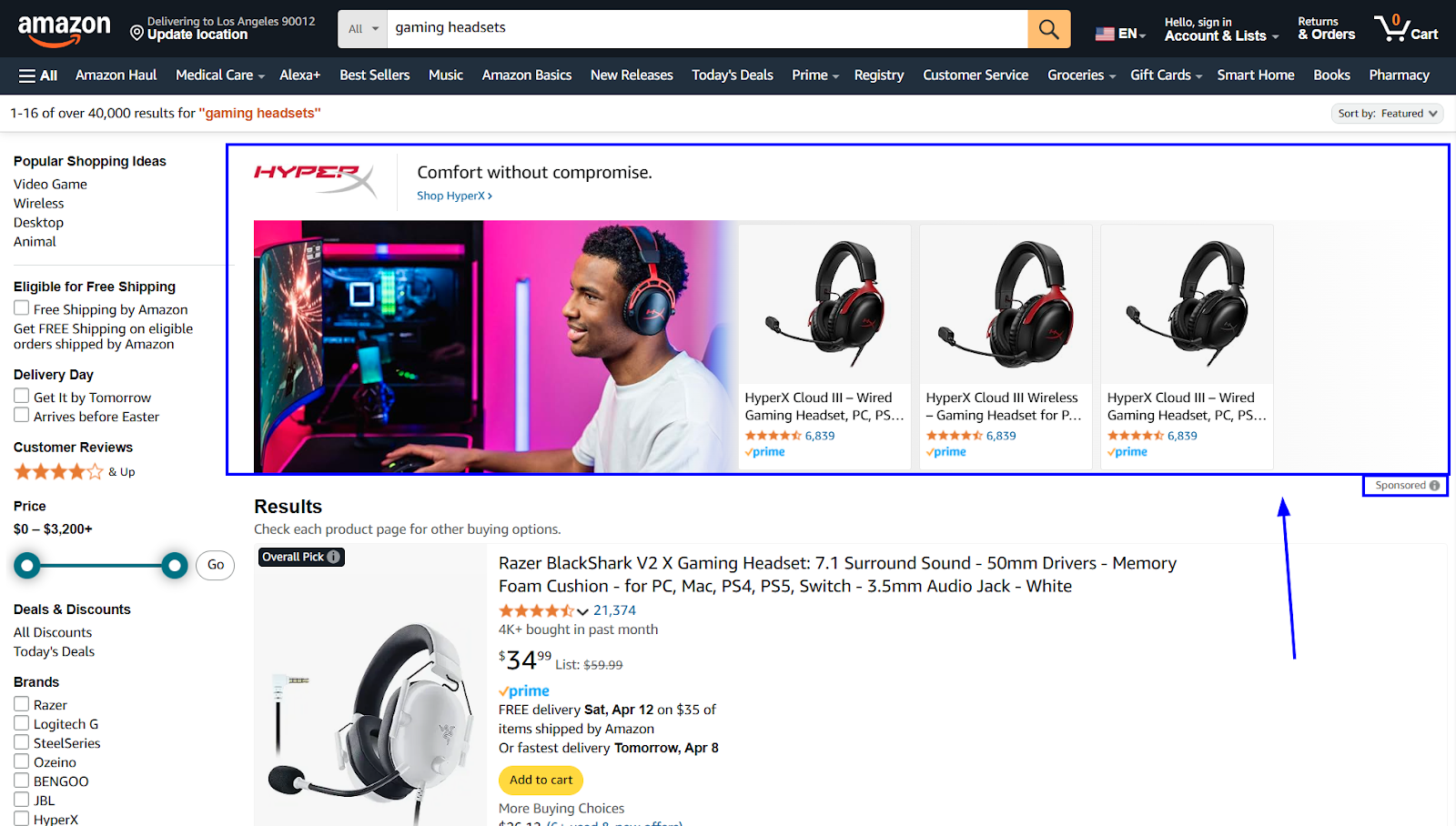
Here’s an example of Native ad placement on Amazon’s product page.
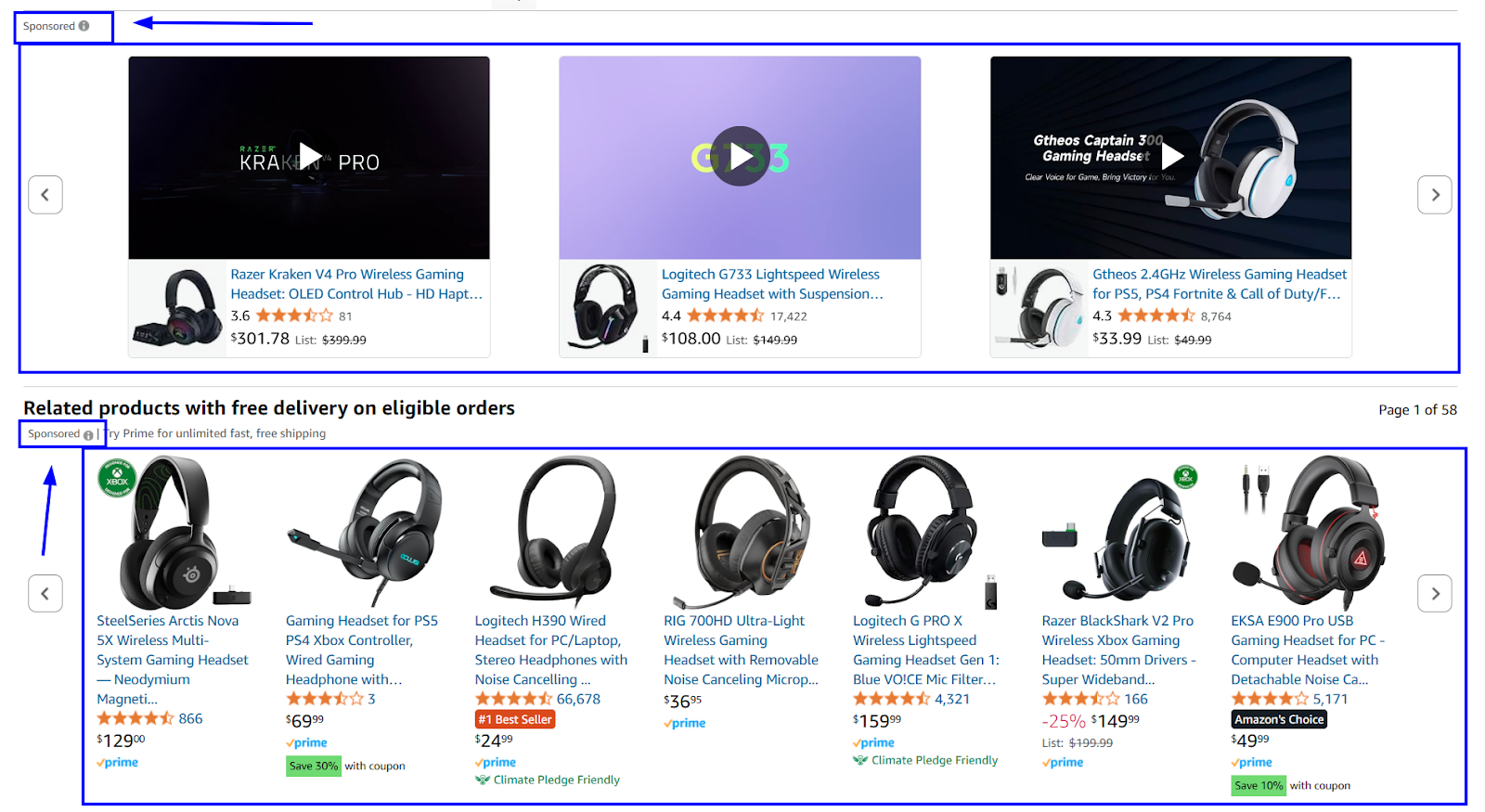
On very first glance, both of them seem to be product recommendations.
❓ Why It Works:
Users on search engines or shopping platforms already have a high purchase intent.
They’re actively looking for that specific product and when advertised with relevancy, promoted listings give brands a way to get in front of these high-intent users right when they’re most likely to click, explore, or buy.
Also, Amazon native ads come in a familiar format, search results or product listings, with a small “Sponsored” or “Ad” tag.
Everything else (title, image, description) feels native, which builds trust and increases the chances of engagement.
Content Recommendations
You’ve seen these dozens of times, at the end of an article or blog post, there’s a row of clickable links that say things like “Recommended for you”, “You might also like”, or “From around the web”.
These are content recommendation widgets, and they’re a subtle but powerful type of native ad example.
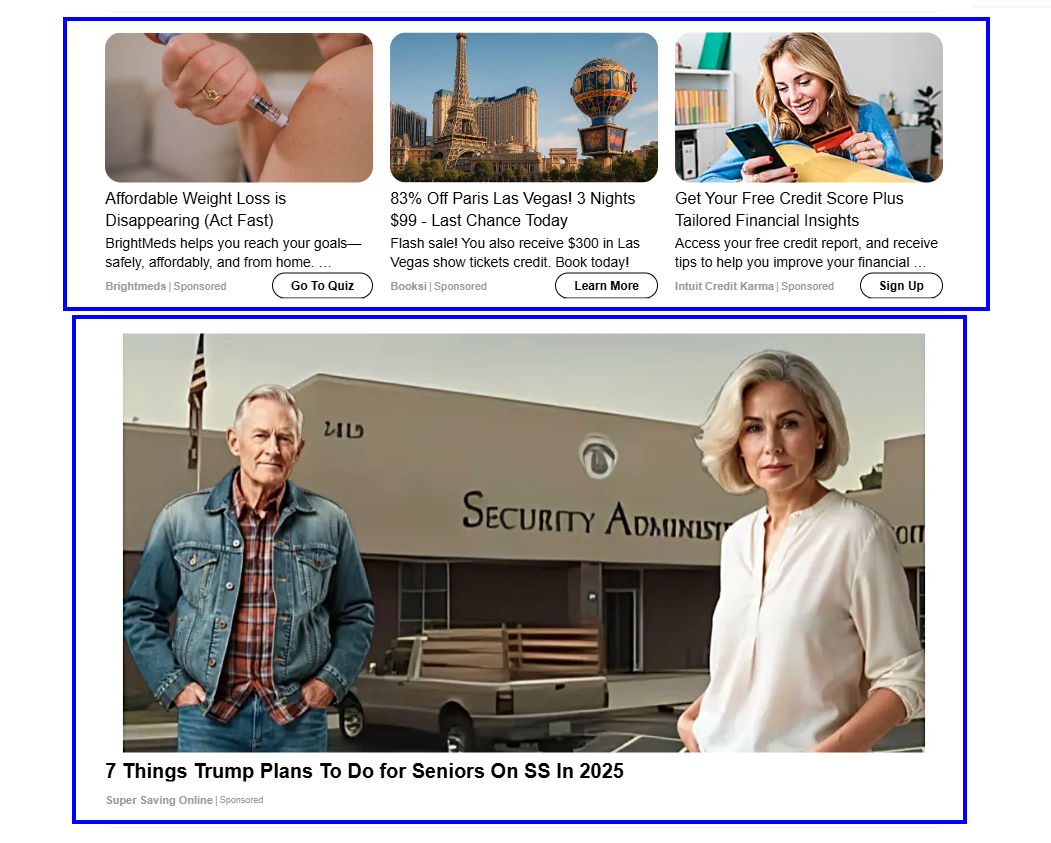
These recommendations are usually powered by platforms like Outbrain, Taboola, or Revcontent, and they promote blog posts, landing pages, videos, or product pages. They’re placed on high-traffic publisher sites that help with native ad distribution in a way that ad is designed to look like part of the reading experience, making users more likely to click on them out of curiosity.
❓ Why It Works:
On such news sites, people are in “exploration mode” when they finish reading an article. And they’re open to discovering new content, especially if it seems relevant or intriguing. These ads tap into that moment of curiosity and offer something that feels like a natural next click.
📌 What You’ll See:
A headline and thumbnail image, often styled similarly to the publisher’s own content. The copy tends to lean into curiosity—things like “The skincare secret dermatologists won’t tell you” or “10 tools content marketers swear by.”
🧠 Where you’ll find them:
- News sites like CNN, Forbes, The Guardian
- Blogs, digital magazines, or niche content platforms
- Under recipe articles, how-to guides, and editorial content
Here’s another example from Freepik, where they’ve added premium and sponsored content as product suggestions.
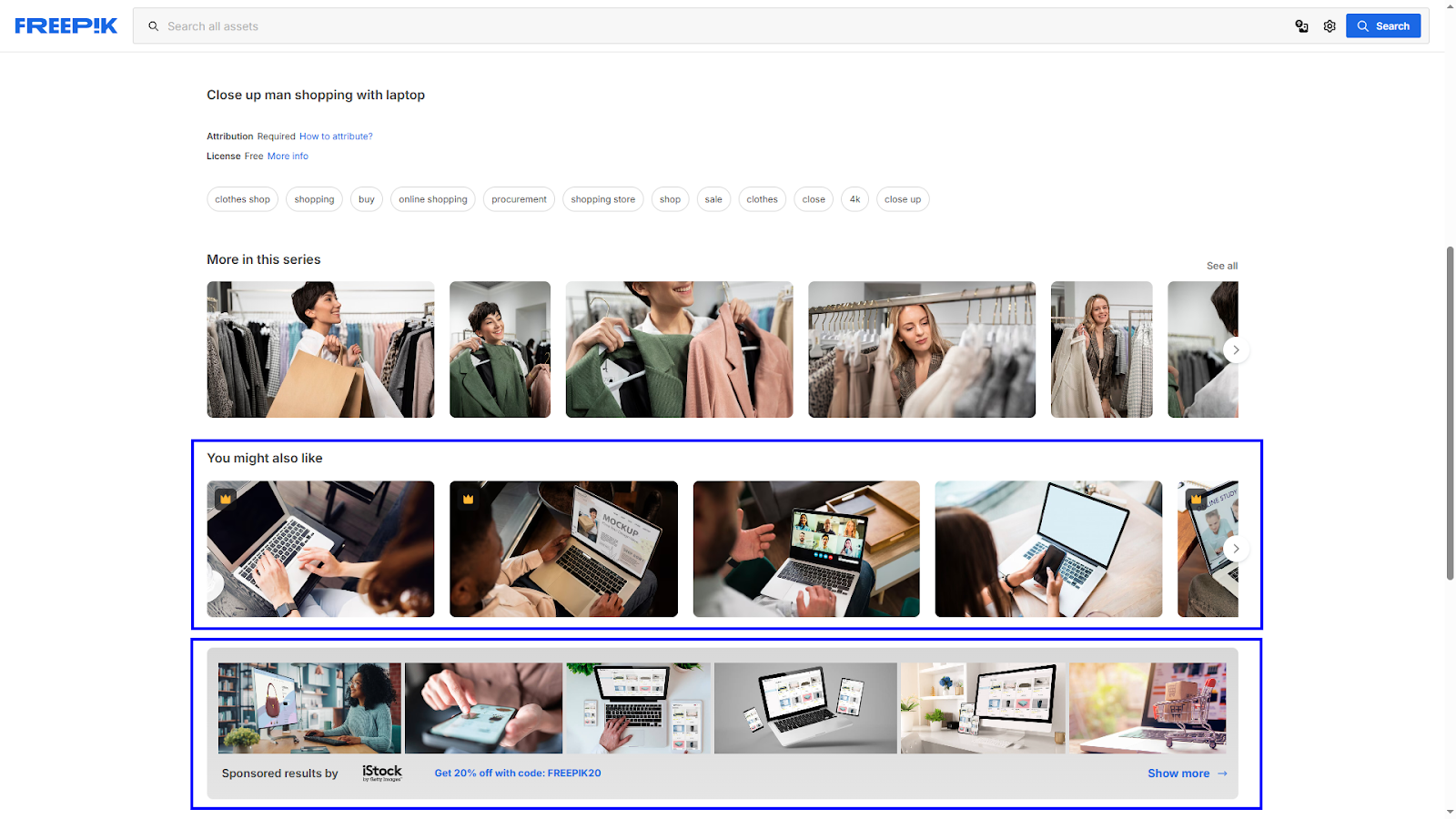
Branded Content (Editorial)
Branded content is another form of Native Ads. You could also call it to be an editorial or a long-form native ad type. This is where native advertising goes all-in on storytelling. Branded content is long-form, editorial-style content that’s created by (or in collaboration with) a brand and is published on a third-party media outlet.
Here are two examples of the same.
First, it shows Netflix’s collaboration with The New York Times for the promotion of the series “Orange Is the New Black”.
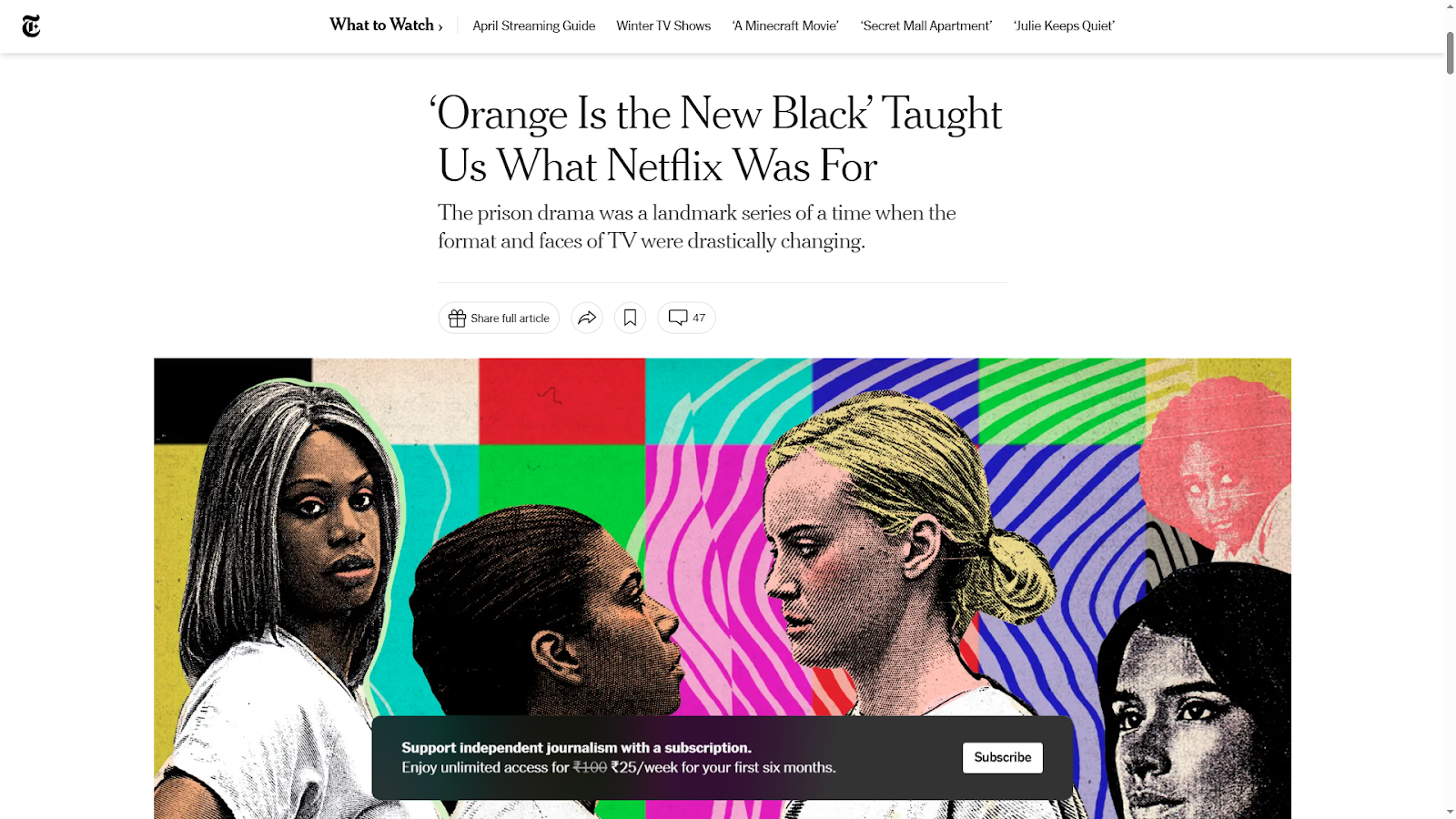
Source: NYTimes
Next up, here’s another example of branded content, a type of native ads, in the form of a youtube video collaboration between DHL and National Geographic.
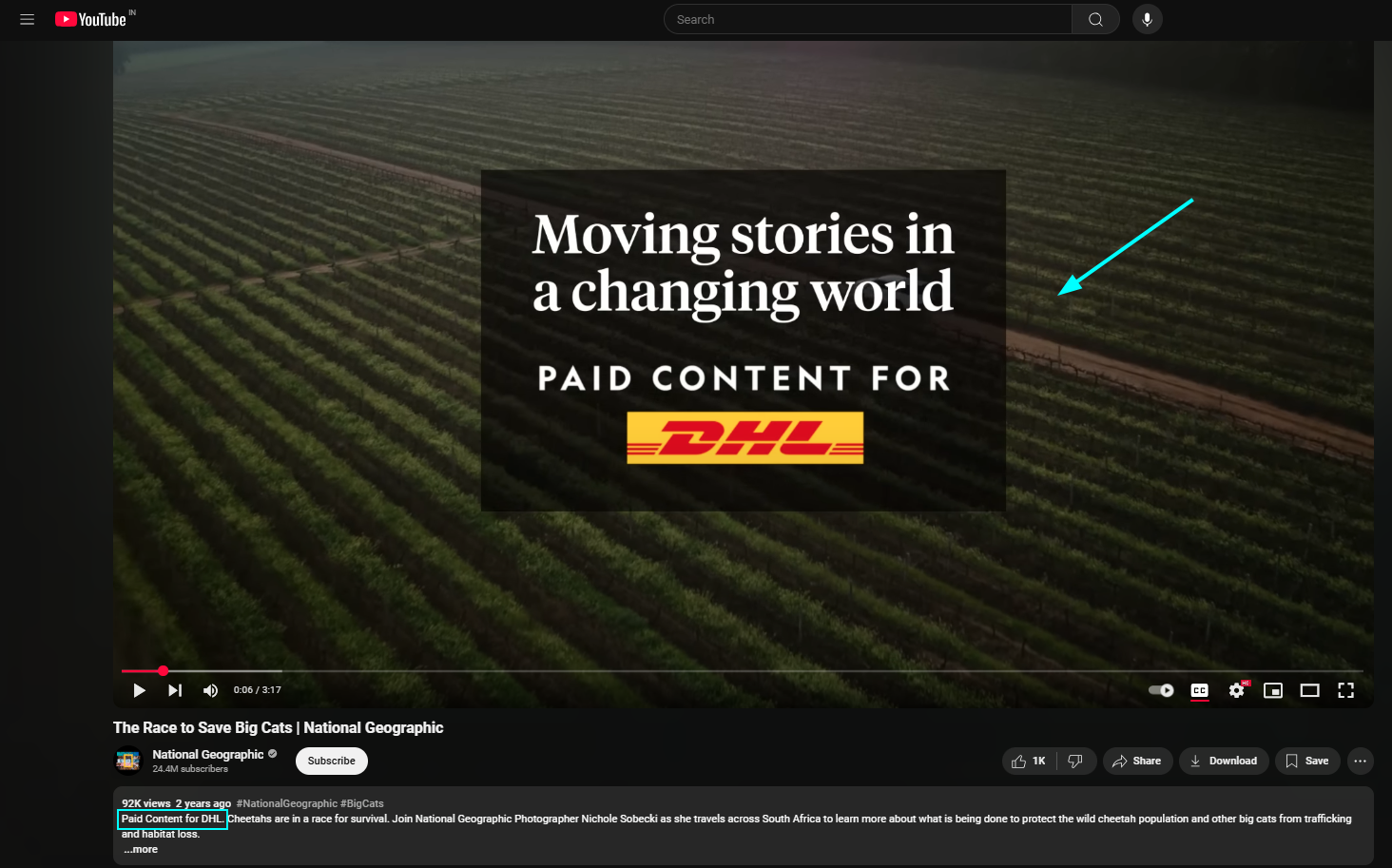
Source: YouTube
This content type is made to add value, educate, or entertain while subtly conveying a brand message. When done well, they don’t feel like ads at all. Instead, they feel like stories worth reading or engaging with.
❓ Why It Works:
People trust the publishers they already read. When a brand shows up there with thoughtful content, it earns credibility by association. Instead of a sales pitch, you’re offering knowledge or entertainment, so people will interest for sure.
📌 What You’ll See:
- Articles labeled “Sponsored” or “Paid Post” on media outlets.
- Video content featuring interviews, stories, or case studies.
- Long-form pieces hosted on publisher platforms but written in a brand voice.
🧠 Where you’ll find them:
- A health brand writing about stress management on WebMD
- Adobe published a piece about creative work on Fast Company
- A fashion brand partnering with Vogue on a behind-the-scenes look at sustainable sourcing
That’s all for the type of native ad formats that you must be aware of as they rule the internet of this age.
Next, let’s check its benefits for your business.
What Are the Native Advertising Benefits?
Running native ads is a smart and strategic way to meet your audience in a crowded digital market.
Here’s why native ads are worth your media dollars.
Higher ROI
First of all, Native ad results tend to outperform traditional display ads when it comes to engagement and conversions.
This is because they feel like part of the content rather than a hard sell. And users are more likely to interact with content that seems less salary and provides true value. This leads to lower cost per acquisition (CPA) and a stronger return on investment (ROI), especially for campaigns focused on awareness, engagement, or sign-ups.
Increased Brand Awareness
Native ads help your brand stay top-of-mind in a way that doesn’t feel like a traditional advertisement. They integrate into the content experience, whether it’s a scroll through Instagram, a product search on Amazon, or reading a news article your audience will see it and won’t avoid or give a side eye as it is not as salesy.
Over time, this kind of subtle, consistent exposure builds trust and recognition. So yes, native ads help you build brand equity without overwhelming your audience.
Custom Creative Opportunities
Unlike rigid ad formats, native advertising allows you to personalize your messaging and visuals to each platform’s style and audience expectations. So, you get to try multiple variations for your ad creative and take benefits of content types specific to platforms.
Those three are major benefits that brands gain when they choose to run their ad campaigns natively.
When should you use native advertising?
Here are four ideal scenarios when you can consider running native ads.
1. When You’re Working With a Tight Budget
Native ads are more cost-effective than traditional display ads. Advertisers typically buy them on a cost-per-thousand (CPM) basis, and their higher click-through rates help lower your cost-per-click. This characteristic makes native ads a smart option when funds are limited.
2. When You Need Greater Accountability
One of the biggest pain points in traditional advertising is measuring performance. However, with native advertising, you get greater capability of extensive performance tracking and accountability measures.
If performance tracking is a priority, native advertising will be perfect for you. Native ad performance measuring involves tracking conversions on a post-click basis, offering clearer insights and tangible proof of ROI compared to traditional display ads.
3. When you want to boost brand content
Getting eyes on your content is harder than ever due to algorithm shifts in search engines and social media. Native ads are a greater alternative to traditional display ads as they seamlessly blend in with the platform’s environment, making them more engaging. So yes, users notice them more compared to overly promotional display ads.
4. When You Want Faster Results Than Content Marketing
Content marketing is powerful but slow-burn.
Native advertising may require a more upfront investment, however, it delivers quicker wins. With higher engagement and visibility, it’s a great complement to your long-term content strategy.
Now let’s check on a few considerations as well.
What are the Challenges and Considerations Before Running Native Ads?
While native advertising has a lot going for it, it’s not without its complexities.
If you’re planning to invest in native, it’s important to go in with eyes wide open because success depends on more than just good ad creative. From ethics to analytics, here are the key challenges and considerations to keep in mind.
Transparency and Ethics
One of the most defining traits of native advertising is how seamlessly it blends into organic content.
But again, if users feel “tricked” into clicking an ad that looks like editorial content, it can damage trust and your brand’s reputation as well. So, make sure to label native ads clearly as “Sponsored”, “Promoted”, “Paid Partnership”, or “Paid Ads“.
Most platforms have built-in disclosures, but it’s also your look out to as a brand to ensure clarity.
Performance Tracking Complexity
Normally, with traditional ads, you can track clear conversions easily. However, native ads often operate with the goal of funnel-focused engagement, awareness, or brand perception.
This can make it harder to measure ROI in the traditional sense.
You might get a lot of time on page, clicks, or video views, but how do you translate it to actual business impact? What’s your ROI?
A potential solution can be setting clear KPIs upfront that go beyond just conversions.
Start by tracking native ad engagement metrics, assisted conversions, brand reputation lift, and even sentiment. Just know that native ads often go in slow, and their full value may not show up in your dashboard right away.
Aligning Content with Native Advertising Platform
The most effective native ads feel like they belong on the platform they appear on. But that means your native content needs to walk on a fine line: it has to match the platform’s editorial tone and standards, without losing your brand voice or objectives.
For example,
- A sponsored post on a news site (known as Advertorial) needs to provide real value, not just sell.
- An in-feed video on Instagram needs to entertain or inspire, not just promote.
What could be a potential solution for native content creation that performs better than just an ad?
You can collaborate with creators, publishers, or platform experts when possible. Prioritize storytelling, visuals, and value first, and then weave in your brand message naturally. Native works best when it feels like a good piece of content that just happens to be sponsored.
Those were a few considerations for you to know before you jump up for a native ad campaign. With that, let’s check on a few tips or standard practices followed when running native ads.
Best Practices for Effective Native Advertising USA
Here are a few native advertising best practices you can follow for running effective native ad campaigns in the USA.
Provide Value & Then Sell
However, if it provides something useful first (a tip, story, idea), people are more likely to pay attention and trust your brand.
You can lead with educational, inspirational, or entertaining content.
For example, a skincare brand might share “5 Morning Habits for Healthier Skin” and later suggest one or a few products, rather than starting an ad with their product itself.
Also, place your CTAs carefully and gently. They should not look harsh on screen but subtle. And if not, your native ad creative will scream to be an ad.
Know Your Audience and Platform
Every platform has its own tone, pace, and user expectations.
What works on LinkedIn might flop on TikTok.
So, make sure you understand that misalignment of ad creatives can lead to ad fatigue and waste of resources.
Here are a few areas you can consider working on for choosing between right native ad platforms:
- Spend time on the platform as a user to understand content norms.
- Study your audience’s pain points, language, and humor.
- Try creative formats
- Use visuals for Instagram
- Conversational tone for Twitter
- Something thoughtful for LinkedIn
Test and Optimize Your Creatives
No ad type is ever perfectly made with a single effort and attempt. So, make sure to keep making small (or big) changes in visuals, headlines, or format to understand performance shifts.
Testing and optimizing regularly will help you figure out what resonates with your audience and chosen platform.
Here are areas you can consider for native ad optimization:
- A/B test headlines, thumbnails, or new hooks.
- Monitoring metrics like scroll depth, engagement rate, and time-on-content.
- Using platform-native tools (Meta Ads Manager, TikTok Ads, Outbrain dashboard) to test variations and iterate quickly.
Finally — How to Get Started With Native Ads?
Here’s how to get started with your very first native ad campaign.
Step 1: Understand What Native Ads Actually Are
Step 2: Choose the Right Native Ads Platform
Step 3: Create Content-Style Ads
Step 4: Set a Small Test Budget
Step 5: Retarget With Better Offers
That’s the overall of process you follow to get started with a native ad campaign.
Rest, our ads experts at Mint Your Store can help you understand native ads better.
Final Words
Native ads are underrated, especially if you’re tired of the rising costs on Meta and Google.
While everyone else is fighting for attention in overcrowded newsfeeds and search results, you can consider running native advertising to stand out and cut through the noise by blending in.
And if you’re already investing in content — blogs, guides, videos — native ads are the natural next step to get more mileage out of those assets. Instead of relying only on SEO or organic reach, you can amplify your best content in a paid format that doesn’t scream “sales pitch”.
Also, you might have heard a myth that native ads are expensive and are for big publishers or agencies with massive budgets.
Well, you can always start small. Test. Learn. And scale what works.
Leave your doubts as comments below and let us help you. 😀
FAQs – Native Advertising
1. How Do You Spot a Native Ad?
You’ll often notice that while the content provides value (like tips, entertainment, or product discovery), it subtly promotes a brand and usually leads to a branded website or landing page when clicked.
2. What are Native and Non-Native Ads?
Native ads are paid advertisements that match the look, feel, and function of the platform they appear on. They blend seamlessly into the surrounding content, adding non-disruptive advertising to the user experience. In contrast, non-native ads (also called traditional or display ads) stand out from the platform. These are more visually distinct and can sometimes interrupt the user’s browsing experience, which often leads to lower engagement rates.
4. When to Use Native Ads?
They’re particularly effective in the early stages of the customer journey, when people are still learning about a problem or exploring solutions. This is because native ads present content in a more natural, less intrusive way.
If you’re running a content-driven strategy or trying to warm up cold traffic, native ads can serve as a subtle yet powerful way to introduce your brand and value.
5. What Type of Businesses Can Run Native Ads?
Any business that has a story to tell or value to educate on can benefit from native advertising including B2B, B2C, and D2C brands. eCommerce stores often use native ads to drive traffic to product reviews, gift guides, or listicles before presenting an offer.
SaaS companies use them to promote thought leadership content, whitepapers, or comparison pages.
Even local businesses or service providers can leverage native ads to build trust by offering helpful content first.
The key is having something worth clicking on, whether it’s an article, native video advertising, or a compelling piece of content that aligns with your customer’s interests. In short, if your brand can educate, entertain, or inform before trying to sell, you’re in a strong position to use native ads effectively.
6. What Are the Platforms That I Can Consider for Running Native Ads?
There are several native advertising platforms to explore.
Taboola and Outbrain are two of the most widely used networks, especially for promoting content on major news and media websites. Next, Revcontent and MGID offer more customization and often come with lower cost-per-click options.
Social platforms like Facebook, Instagram, LinkedIn, and Twitter also run native-style in-feed ads that resemble organic posts, making them very effective for storytelling and engagement.
Even Google plays a strong role in the native space with its Discovery and Responsive Display Ads.
But again, the best native advertising platform for you will depend on your goals, content type, and target audience.
5. Does Google Do Native Ads?
Yes, Google does offer native advertising options.
Through the Google Display Network (GDN), advertisers can run Responsive Display Ads, which automatically adapt in size, appearance, and format to match the look and feel of the websites they appear on, essentially functioning as native ads.
